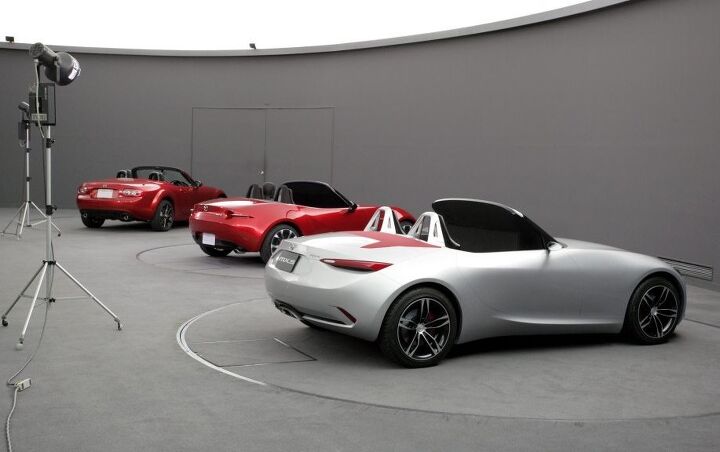Mazda Reveals a Treasure Trove of MX-5 Miata Design History, Shows How We Got the Fourth-gen ND Miata
The end result is tasty. Maybe the narrow headlamps are sliced too thinly; the hood cut line that intersects with the housing too obvious. Perhaps the rear end could use a bit more breadth. The wheels still appear a bit small from some angles.
But the fourth-generation Mazda MX-5 Miata — known in Mazda circles as the ND, succeeding the NA, NB, and NC — is generally regarded as an eye-catching, modern, successful evolution of the venerable Mazda sports car.
How did Mazda arrive at the end result? What led Mazda to settle on the final production version? Which styling direction was rejected?
In a fit of transparency, Mazda’s PR department has released the entire background of the process, including 140 photos detailing the evolution of what would become the fourth-generation Mazda MX-5.
A new MX-5 is a big deal, not just because it serves as a global status symbol for the Mazda brand, not just because it’s an enthusiast-oriented car often covered by enthusiast press. The dawn of a new MX-5 is a big deal because it’s such a rare occurrence.
Nearly a decade passed by between the production start of the third-gen Miata and the ND Miata’s unveiling in September 2014. That’s a lot of time to think about what the next Miata is going to look like.
Mazda was strict with its internal objectives. “The car had to be lighter, smaller, more efficient and with a design that shared little between it and other Mazda vehicles,” Mazda says. Led by Ikuo Maeda, Mazda began working on the appearance of the fourth-gen Miata in 2011, with designers in Europe, the U.S., and Japan.
Although Mazda wanted the new Miata to return to its roots, it couldn’t just be a car that appealed to fans of the 1990 Miata. Newly licensed drivers of today weren’t born until 2001, more than a decade after the first Miata arrived in America.
Mazda says its designers’ goals required them to style a car that was “simple and distinct” yet also “emotional and expressive” — conflicting expectations that inevitably slowed the process. Mazda’s Japanese designers ended up styling a car that Mazda’s American designers found in February 2012 to be too similar to the original NA Miata. Mazda’s Japanese designers, on the other hand, felt the Americans’ Miata “didn’t capture raw emotional excitement.”
One theory didn’t win out over the other, as the designers began to adopt the Japanese theme while integrating U.S. and European detailing for a car that would appear “uniquely Japanese” but still “globally relevant.” The final proposals were revealed inside Mazda in October 2012.
But that was just the body, so Mazda then went to work on the ND’s face. The pop-up headlights made possible a low-slung front fascia in the first Miata that Mazda felt had been lost in successive generations. With no chance of bringing pop-ups back, Mazda still wanted to bring the front end appearance closer to the ground. Mazda’s European designers’ approach was vital in this regard. Adopting LEDs made possible a lower hood line, as well.
By the end of 2013, Mazda was tinkering with the final version in anticipation of 2014’s September reveal.
Besides conflicting internal voices, conflicting priorities stand in the way of an automaker producing any sports car designer’s ideal design. The production BMW Z4, for instance, won’t offer some of the more extravagant detailing and surfacing of the roadster concept unveiled last week. Yet while we’d all, in our own subjective way, choose elements of the latest MX-5 to change, the new MX-5 does appeaer to be every inch a Miata and yet strikingly different from the NC Miata that lingered from 2006 until 2015.
Surely on that point we can all agree that Mazda did what Mazda intended to do.
[Images: Mazda]
Timothy Cain is a contributing analyst at The Truth About Cars and Autofocus.ca and the founder and former editor of GoodCarBadCar.net. Follow on Twitter @timcaincars.
More by Timothy Cain
Latest Car Reviews
Read moreLatest Product Reviews
Read moreRecent Comments
- Dave Holzman Golden2husky remember you from well over decade ago in these comments. If I wanted to have a screen name that reflected my canine companionship, I'd be BorderCollie as of about five years go. Life is definitely better with dogs.
- Dave Holzman You're right about that!
- EBFlex It will have exactly zero effect
- THX1136 What happened to the other companies that were going to build charging stations? Maybe I'm not remembering clearly OR maybe the money the government gave them hasn't been applied to building some at this point. Sincere question/no snark.
- VoGhost ChatGPT, Review the following article from Automotive News: and create an 800 word essay summarizing the content. Then re-write the essay from the perspective of an ExxonMobil public relations executive looking to encourage the use of petroleum. Ensure the essay has biases that reinforce the views of my audience of elderly white Trump-loving Americans with minimal education. Then write a headline for the essay that will anger this audience and encourage them to read the article and add their own thoughts in the comments. Then use the publish routine to publish the essay under “news blog” using Matt Posky listing the author to completely subvert the purpose of The Truth About Cars.






































Comments
Join the conversation
I love the Bugs Bunny Tokio Jokio look of the bottom pics.
Is there a link anywhere showing all 140 concepts?